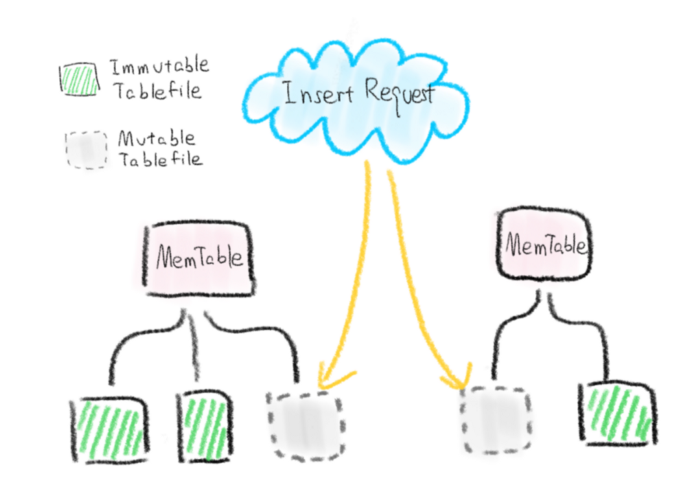Milvus is an open-source vector similarity search engine powered by approximate nearest neighbor search (ANNS) algorithms such as Faiss, NMSLIB, and Annoy.
To make a vector search more intuitive and convenient, we introduced TableFile and metadata in Milvus.
In this article, we will mainly describe how vector data are recorded in the memory of Milvus, and how these records are maintained.
Below are our main design goals:
- The efficiency of data import should be high.
- Data can be seen as soon as possible after data import.
- Avoid fragmentation of data files.
Therefore, we have established a memory buffer (insert buffer) to insert data to reduce the number of context switches of random I/O on the disk and operating system to improve the performance of data insertion. The memory storage architecture based on MemTable and MemTableFile enables us to manage and serialize data more conveniently. The state of the buffer is divided into Mutable and Immutable, which allows the data to be persisted to disk while keeping external services available.
Preparation
When the user is ready to insert a vector into Milvus, he first needs to create a Collection (* Milvus renames Table to Collection in 0.7.0 version). The collection is the most basic unit for recording and searching vectors in Milvus.
Each Collection has a unique name and some properties that can be set, and vectors are inserted or searched based on the Collection name. When creating a new Collection, Milvus will record the information of this Collection in the metadata.
Data Insertion
When the user sends a request to insert data, the data are serialized and deserialized to reach the Milvus server. Data are now written into memory. Memory writing is roughly divided into the following steps:

- In MemManager, find or create a new MemTable corresponding to the name of the Collection. Each MemTable corresponds to a Collection buffer in memory.
- A MemTable will contain one or more MemTableFile. Whenever we create a new MemTableFile, we will record this information in the Meta at the same time. We divide MemTableFile into two states: Mutable and Immutable. When the size of MemTableFile reaches the threshold, it will become Immutable. Each MemTable can only have one Mutable MemTableFile to be written at any time.
- The data of each MemTableFile will be finally recorded in the memory in the format of the set index type. MemTableFile is the most basic unit for managing data in memory.
- At any time, the memory usage of the inserted data will not exceed the preset value (insert_buffer_size). This is because every request to insert data comes in, MemManager can easily calculate the memory occupied by the MemTableFile contained in each MemTable, and then coordinate the insertion request according to the current memory.
Through MemManager, MemTable, and MemTableFile multi-level architecture, data insertion can be better managed and maintained. Of course, they can do much more than that.
Near Real-time Query
In Milvus, from the data are recorded in the memory, to the data can be searched, you only need to wait for one second at the fastest. This entire process can be roughly summarized by the following picture:

First, the inserted data will enter an insert buffer in memory. The buffer will periodically change from the initial Mutable state to the Immutable state in preparation for serialization. Then, these Immutable buffers will be serialized to disk periodically by the background serialization thread. After the data are placed, the order information will be recorded in the metadata. At this point, the data can be searched!
Now, we will describe the steps in the picture in detail.
#data #opensource #leveldb #anns #rocksdb #vector embeddings
